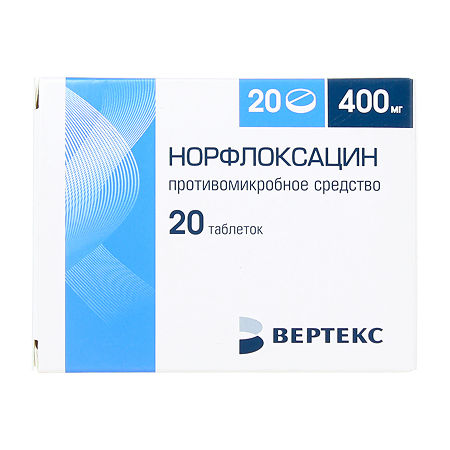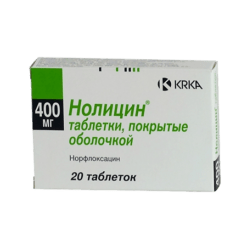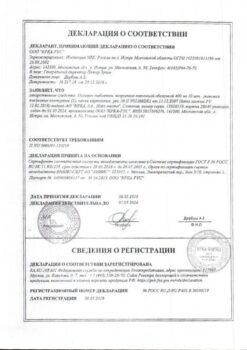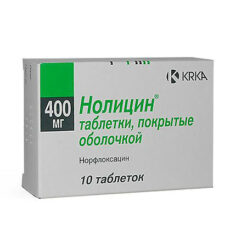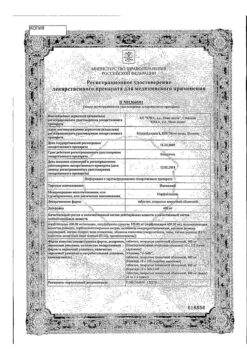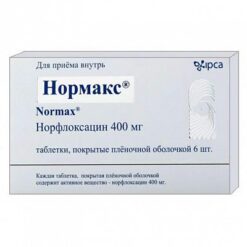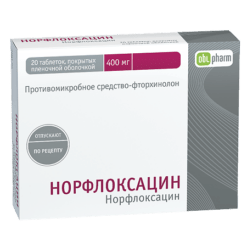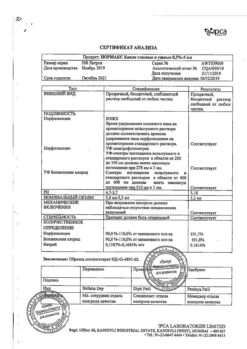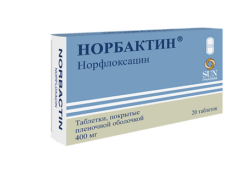No products in the cart.
Norfloxacin 400 mg, 20 pcs.
€1.00
Out of stock
(E-mail when Stock is available)
Description
Norfloxacin is an antibacterial agent.
It is used to treat infectious and inflammatory diseases such as pyelonephritis, cystitis, urethritis, gonorrhea, prostatitis, intestinal infections, ophthalmic and ENT infections.
Indications
Indications
Infections caused by microorganisms sensitive to norfloxacin: urinary tract infections (except acute and chronic complicated pyelonephritis), prostatitis, uncomplicated gonorrhea.
Active ingredient
Active ingredient
Composition
Composition
One film-coated tablet contains:
active ingredient:
norfloxacin – 400,000 mg;
excipients:
microcrystalline cellulose – 143,000 mg;
croscarmellose sodium – 36,000 mg;
povidone (low-molecular polyvinylpyrrolidone) – 12,000 mg;
silicon dioxide colloid – 3.000 mg;
magnesium stearate – 6,000 mg;
film shell:
[hypromellose – 9,000 mg, hyprolose (hydroxypropyl cellulose) – 3,490 mg, talc – 3,470 mg, titanium dioxide – 1,956 mg, iron oxide yellow (iron oxide) – 0,084 mg] or [dry film-coating mixture containing hypromellose (50%), hyprolose (hydroxypropyl cellulose) (19.4%), talc (19.26%), titanium dioxide (10.87%), iron oxide yellow (iron oxide) (0.47%)] – 18,000 mg
How to take, the dosage
How to take, the dosage
Intravenously.
In urinary tract infections – 400 mg 2 times a day for 7-10 days; in uncomplicated cystitis – 3-7 days; in chronic recurrent urinary tract infection – up to 12 weeks.
In acute bacterial gastroenteritis – 5 days.
In acute gonococcal urethritis, pharyngitis, proctitis, cervicitis – once 800 mg.
In typhoid fever – 400 mg 3 times a day for 14 days.
For prevention of sepsis – 400 mg 2 times a day.
For prophylaxis of bacterial gastroenteritis – 400 mg/day.
To prevent travelers’ diarrhea, 400 mg/day 1 day before departure and for the entire period of travel (not more than 21 days).
To prevent recurrent urinary tract infections, 200 mg/day.
In patients with impaired renal function at CK values over 20 ml/min do not require dosage adjustment. In patients with CKD less than 20 ml/min (or serum creatinine concentration more than 5 mg/100 ml) and in patients undergoing hemodialysis a 1/2 of therapeutic dose 2 times a day or a full dose 1 time daily is administered.
Interaction
Interaction
Concomitant use of norfloxacin with warfarin increases the anticoagulant effect of the latter.
Concomitant use of norfloxacin with cyclosporine leads to increased plasma concentrations of the latter.
When concomitant use of norfloxacin and antacids or agents containing iron, zinc, magnesium, calcium or sucralfate decreases absorption of norfloxacin due to formation of complexons with metal ions (interval between doses must be at least 4 hours).
Concomitant use of norfloxacin decreases clearance of theophylline by 25%; therefore, if used concomitantly the dose of theophylline should be reduced.
The concomitant administration of norfloxacin with drugs that have the potential to decrease BP may cause a sharp decrease in BP. In this regard in such cases as well as in concomitant administration of barbiturates and anesthetics it is necessary to monitor HR, BP and ECG parameters. Concomitant use with drugs that lower the epileptic threshold may lead to the development of epileptiform seizures.
Decreases the effect of nitrofurans.
Special Instructions
Special Instructions
Use the drug with caution in the following diseases:
Epilepsy, seizure syndrome, renal/liver failure, myasthenia gravis.
During the therapy patients should receive plenty of fluids (under the control of diuresis).
During the therapy the prothrombin index may increase (during surgical interventions the condition of the blood-clotting system should be monitored).
During the treatment it is necessary to avoid direct sunlight.
Norfloxacin, like other fluoroquinolones, may cause tendinitis and tendon rupture. Risk factors: age over 60, use of glucocorticosteroids, kidney, heart or lung transplantation, increased physical activity, CKD, tendon damage in anamnesis (including rheumatoid arthritis). These phenomena may also occur several months after the end of the drug. At the first signs of tendinitis or tendon rupture the use of norfloxacin should be stopped and a physician should be consulted.
Norfloxacin can lower seizure threshold and cause seizures; fluoroquinolones can also stimulate the CNS, causing tremors, toxic psychosis, anxiety, confusion, and hallucinations; and increased intracranial pressure.
Norfloxacin may lead to the development of pseudomembranous colitis caused by Clostridium difficile. In this case it is necessary to cancel the drug and prescribe appropriate treatment (oral vancomycin or metronidazole).
Not effective in syphilis.
Norfloxacin may cause peripheral neuropathy (paresthesias, hypoesthesia, dysesthesias, muscle weakness). At the first signs of neuropathy (pain, tingling, numbness or weakness in the extremities, other types of sensitivity disorders) to avoid irreversible changes the drug should be canceled.
In order to avoid formation of norfloxacin crystals in the kidneys, the recommended doses should not be exceeded; the tablets should be filled with sufficient fluids.
Contraindications
Contraindications
Hypersensitivity; tendinitis, tendon rupture caused by fluoroquinolones (including anamnesis); pregnancy, lactation, childhood, glucose-6-phosphate dehydrogenase deficiency.
Side effects
Side effects
Central nervous system (CNS) disorders: dizziness, headache, tingling in the fingers, drowsiness, anxiety, depression, insomnia, sleep disturbance.
Digestive system disorders: nausea, abdominal pain, anorexia, diarrhea, pain in the rectum or anus, constipation, dyspepsia, flatulence, vomiting, dry oral mucosa, heartburn, loose stools, bitter taste in the mouth, oral mucosa ulceration, anus itching.
Hematopoietic disorders: leukopenia, thrombocytopenia, eosinophilia, neutropenia.
Skin disorders: itching, rash, erythema, urticaria.
Sensory organs: blurred vision.
Musculoskeletal disorders: bursitis, swollen hands and feet.
Cardiovascular system (CVS): myocardial infarction, palpitations.
Urinary system disorders: renal colic.
Laboratory measures: increase of AST, ALT, ALT, LDH activity, proteinuria, decrease of hematocrit and Hb, increase of urea concentration in blood, hypercreatininemia, glucosuria.
Other: hyperhidrosis, asthenia, back pain, fever, chills, chest pain, dysmenorrhea, edema, allergic reactions.
Overdose
Overdose
In case of overdose, the stomach must be emptied by inducing vomiting or by gastric lavage with a probe, and the patient should be carefully examined and subjected to symptomatic and supportive treatment. Water-salt metabolism should be monitored and the patient should receive plenty of fluids to avoid urinary tract stones.
Similarities
Similarities
Additional information
| Weight | 0.025 kg |
|---|---|
| Shelf life | 2 years |
| Conditions of storage | The drug should be stored at a temperature not exceeding 25 ° C in a place out of the reach of children. |
| Manufacturer | Vertex, Russia |
| Medication form | pills |
| Brand | Vertex |
Other forms…
Related products
Buy Norfloxacin 400 mg, 20 pcs. with delivery to USA, UK, Europe and over 120 other countries.

